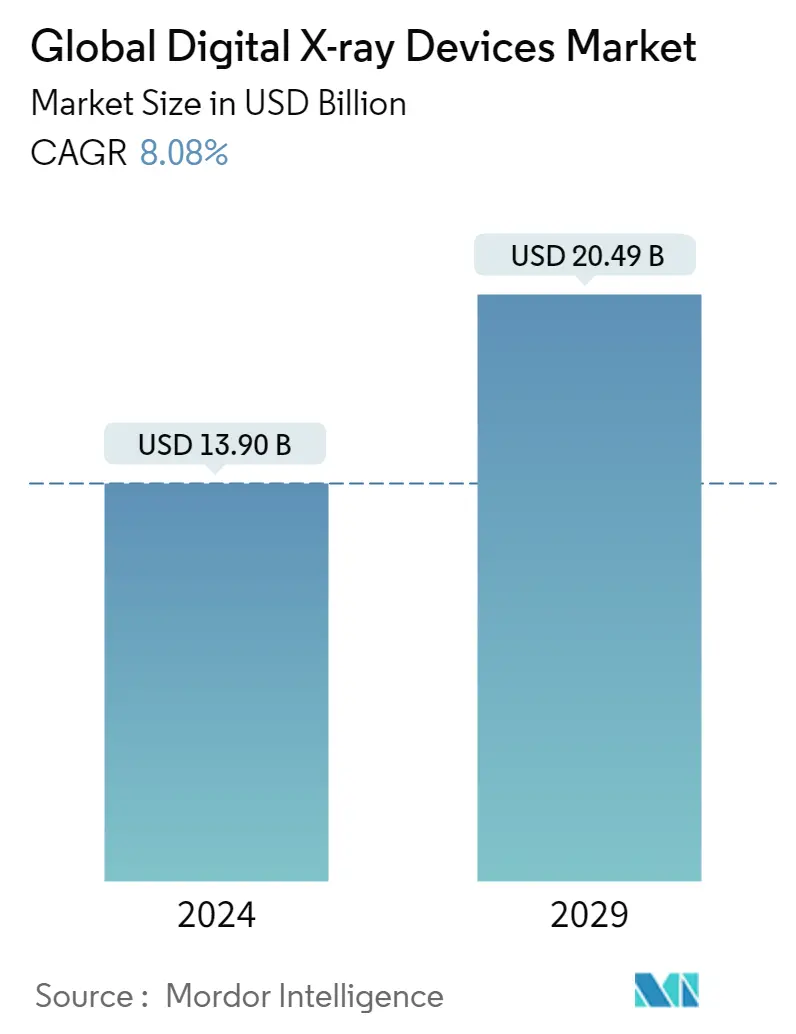Market Size of Global Digital X-ray Devices Industry

| Study Period | 2019 - 2029 |
| Market Size (2024) | USD 13.90 Billion |
| Market Size (2029) | USD 20.49 Billion |
| CAGR (2024 - 2029) | 8.08 % |
| Fastest Growing Market | Asia Pacific |
| Largest Market | North America |
Major Players
*Disclaimer: Major Players sorted in no particular order |
Need a report that reflects how COVID-19 has impacted this market and its growth?
Digital X-ray Devices Market Analysis
The Global Digital X-ray Devices Market size is estimated at USD 13.90 billion in 2024, and is expected to reach USD 20.49 billion by 2029, growing at a CAGR of 8.08% during the forecast period (2024-2029).
The COVID-19 pandemic has turned the spotlight on diagnostic imaging, particularly on digital X-ray devices. Digital imaging plays a key role in the diagnosis of COVID-19 and indicates the affected lung tissue in infected patients. Several key market players had focused on innovations in the production of radiography equipment. For instance, in December 2020, Agfa HealthCare launched its new SmartXR for X-ray Artificial Intelligence (AI) for Digital Radiography portfolio to aid during the radiology routine, which has proven important during the COVID-19 crisis. Thus, during the pandemic, the digital X-rays devices market is expected to be positively impacted by COVID-19 accurate diagnosis and treatment.
The studied market growth can largely be attributed to factors, such as the increasing occurrence of orthopedic diseases and cancers, the increasing number of serious injuries, the advantages of digital X-ray systems over conventional X-rays, technological advancements, and product development. Digital X-ray devices use digital x-ray sensors instead of films to capture images. This results in an immediate preview of the images that ultimately improves time efficiency and capacity to digitally transfer images.
The major advantages of digital imaging are cost-effectiveness and easy accessibility. The hospitals can manage the cost-cutting by lowering the film price, reducing the requirement of storage space, and decreasing the number of people required to run the services and archive sections. The images are also instantly available for distribution to the clinical services without the time and physical effort needed to retrieve film packets and reviewing previous imaging on a patient is much easier. This factor majorly impacts the growth of the digital X-ray devices market. Digital X-rays expose approximately 70-80% less radiation than conventional X-rays. This is hugely beneficial for the long-term health of patients, especially pregnant women or patients who are already suffering from illness, thus ensuring safety. With the help of digital X-rays, dentists can now easily recognize oral issues, which is leading to a declining need for an invasive investigation at the diagnosis stage. Additionally, digital radiography safely stores patient X-rays, resulting in no loss from the holders.
Also, due to the increase in the number of dental disorders, cardiac disorders, cancers especially breast cancer, there is an increased demand for digital X-ray devices globally. The American Heart Association (AHA), Heart Disease and Stroke Statistics - 2022 Update data shows that cardiovascular disease (CVD) is listed as the primary underlying cause of death accounting for 19.05 million deaths all over the world in the year 2020. As per the same source, around 7.08 million deaths worldwide were attributed to cerebrovascular diseases in the year 2020. Such a high prevalence of cardiac disease among the population in the country reaped the demand for imaging devices with precise diagnosis and hence Digital X-ray devices acquire their importance in this context.
Additionally, the advancements in technology and increasing product approvals, along with partnerships and collaborations by key players are helping in the market growth. For instance, in February 2022, Carestream Health India has announced the launch of the DRX Compass, an accurate, convenient and configurable digital radiation solution that provides radiologists with a whole new level of efficiency. In addition, DRX Compass provides versatility for configuring desired configurations from a wide range of detectors, tubes, generators, stages and collimators, and how radiation facilities deploy this futuristic digital radiation technology.
Thus, all the aforementioned factors are currently augmenting the growth of the digital X-ray devices market. However, the high installations and device cost, along with the rise in the use of refurbished devices are likely to hinder the market growth.
